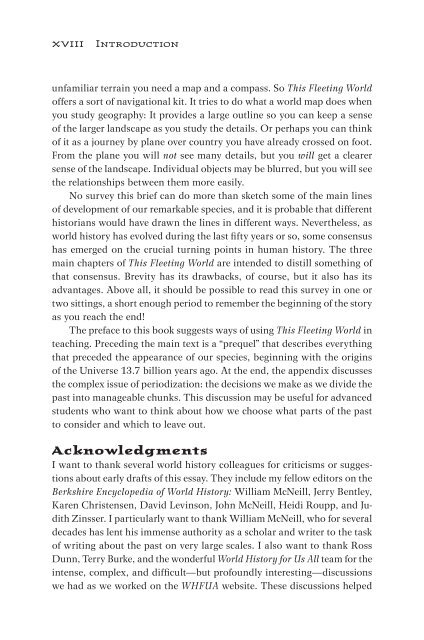This Fleeting World
This Fleeting World
This Fleeting World
Create successful ePaper yourself
Turn your PDF publications into a flip-book with our unique Google optimized e-Paper software.
xviii Introduction<br />
unfamiliar terrain you need a map and a compass. So <strong>This</strong> <strong>Fleeting</strong> <strong>World</strong><br />
offers a sort of navigational kit. It tries to do what a world map does when<br />
you study geography: It provides a large outline so you can keep a sense<br />
of the larger landscape as you study the details. Or perhaps you can think<br />
of it as a journey by plane over country you have already crossed on foot.<br />
From the plane you will not see many details, but you will get a clearer<br />
sense of the landscape. Individual objects may be blurred, but you will see<br />
the relationships between them more easily.<br />
No survey this brief can do more than sketch some of the main lines<br />
of development of our remarkable species, and it is probable that different<br />
historians would have drawn the lines in different ways. Nevertheless, as<br />
world history has evolved during the last fifty years or so, some consensus<br />
has emerged on the crucial turning points in human history. The three<br />
main chapters of <strong>This</strong> <strong>Fleeting</strong> <strong>World</strong> are intended to distill something of<br />
that consensus. Brevity has its drawbacks, of course, but it also has its<br />
advantages. Above all, it should be possible to read this survey in one or<br />
two sittings, a short enough period to remember the beginning of the story<br />
as you reach the end!<br />
The preface to this book suggests ways of using <strong>This</strong> <strong>Fleeting</strong> <strong>World</strong> in<br />
teaching. Preceding the main text is a “prequel” that describes everything<br />
that preceded the appearance of our species, beginning with the origins<br />
of the Universe 13.7 billion years ago. At the end, the appendix discusses<br />
the complex issue of periodization: the decisions we make as we divide the<br />
past into manageable chunks. <strong>This</strong> discussion may be useful for advanced<br />
students who want to think about how we choose what parts of the past<br />
to consider and which to leave out.<br />
Acknowledgments<br />
I want to thank several world history colleagues for criticisms or suggestions<br />
about early drafts of this essay. They include my fellow editors on the<br />
Berkshire Encyclopedia of <strong>World</strong> History: William McNeill, Jerry Bentley,<br />
Karen Christensen, David Levinson, John McNeill, Heidi Roupp, and Judith<br />
Zinsser. I particularly want to thank William McNeill, who for several<br />
decades has lent his immense authority as a scholar and writer to the task<br />
of writing about the past on very large scales. I also want to thank Ross<br />
Dunn, Terry Burke, and the wonderful <strong>World</strong> History for Us All team for the<br />
intense, complex, and difficult—but profoundly interesting—discussions<br />
we had as we worked on the WHFUA website. These discussions helped


